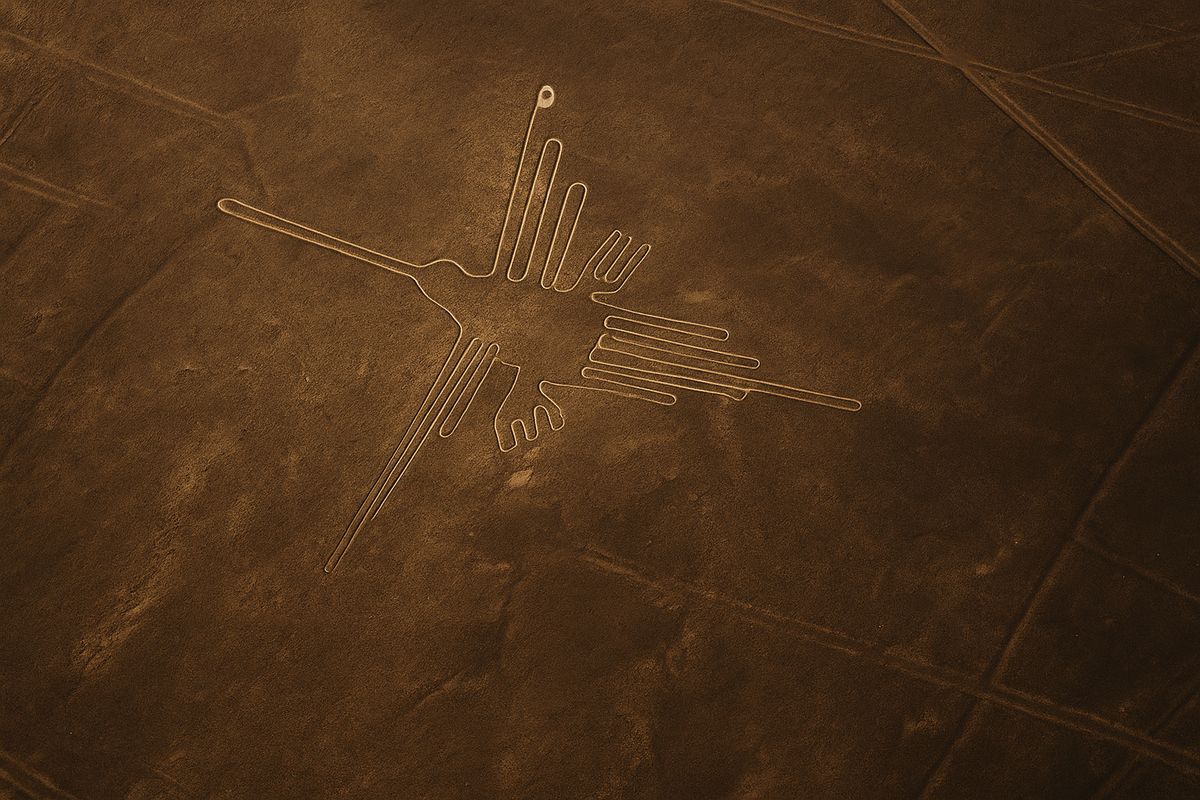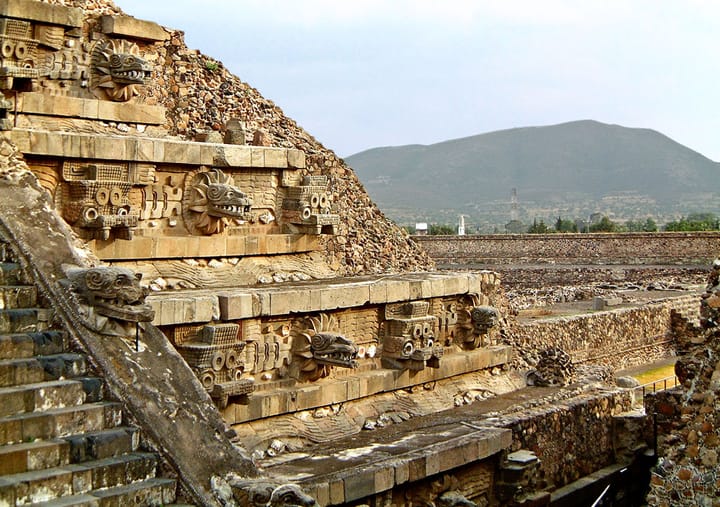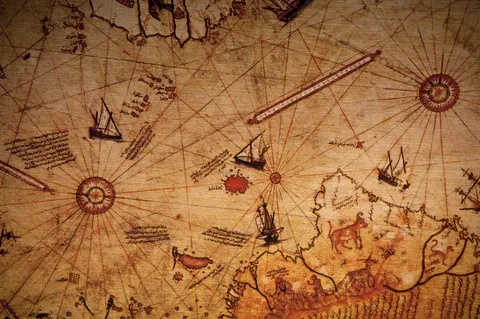Nazca Lines
Stretched across Peru’s coastal desert, the Nazca Lines form massive geometric shapes and animals made by clearing dark stones to reveal pale earth. Built roughly 200 BCE to 600 CE, they still spark debate about purpose, meaning, and how they were organized

Quick Take
- Hundreds of geoglyphs carved into the pampas by removing surface stones to reveal lighter sediment below
- Dates cluster in the Nazca culture horizon, roughly 200 BCE to 600 CE
- Designs include long straight lines, trapezoids, spirals, and iconic figures like the hummingbird, spider, monkey, and condor
- Functions proposed include ritual pathways, water and fertility rites, horizon alignments, and processional art
- New glyphs are still being cataloged with survey, drones, and satellite imagery
Quick Facts
- Type: Monumental geoglyph complex
- Location: Nazca and Palpa pampas, south coast of Peru
- Period: Late Paracas through Nazca culture, c. 200 BCE to 600 CE
- Technique: Stone clearance exposing pale subsoil; some figures made with shallow trenches
- Preservation: Aridity, stable winds, and desert varnish help long term survival
- UNESCO: Inscribed as a World Heritage Site in the 1990s
Why This Matters
The Nazca Lines are one of the largest landscape artworks on Earth and a masterclass in organizing big projects without metal tools, draft animals, or writing on stone. They compress engineering, ritual, and landscape knowledge into clean lines that still hold up under satellite zoom. Understanding how and why they were built helps decode how early societies turned deserts into cultural stages.
Timeline
- Early 20th century — First systematic notes by Peruvian researchers and pilots
- 1930s to 1960s — Detailed mapping and protection campaigns, including Maria Reiche’s surveys
- 1990s — UNESCO inscription prompts formal conservation frameworks
- 2000s to present — Aerial, satellite, and drone surveys expand the catalog and refine typology
Claims and Evidence
Claim 1: The geoglyphs were planned on the ground with simple tools.
- Evidence: Mapping shows consistent use of stakes, strings, and sightlines. Straight lines run for kilometers with minimal deviation.
- Assessment: Strong. Demonstrates high organizational skill with simple tech.
Claim 2: Many lines align with local topography and horizons, not only stars.
- Evidence: Clusters terminate at hills, water sources, and ridges. Some trapezoids frame distant viewpoints.
- Assessment: Strong for landscape intent. Sky alignments remain case by case.
Claim 3: Processional and ritual use explains wear patterns and path-like geometry.
- Evidence: Path widths and repeated parallel lines read like routes more than pictures meant only for viewing.
- Assessment: Plausible and widely discussed, with room for multiple overlapping functions.
Claim 4: Iconic figures reflect Nazca art styles found on textiles and ceramics.
- Evidence: Hummingbird, monkey, and killer whale motifs appear in portable art with similar stylization.
- Assessment: Strong cultural linkage.
Network and Influence
- Culture area: Paracas and Nazca traditions on Peru’s south coast
- Key figures in research: Toribio Mejía Xesspe, Paul Kosok, Maria Reiche, later Peruvian and international teams
- Related sites: Palpa geoglyphs, Cahuachi ceremonial center, Pampas de Jumana
- Modern echoes: Runways, aerial photography, satellite mapping, and trans-desert art projects
Key Documents and Media
- Site management plans and conservation briefs
- Survey maps and photogrammetry sets
- Museum overviews on Nazca ceramics, textiles, and iconography
- Peer reviewed studies on geoglyph construction and dating
Controversies
- Purpose debates: Calendar, water rituals, pilgrimage routes, horizon markers, or all of the above
- Viewability myths: Often said to be only visible from airplanes, yet many figures are legible from surrounding hills
- Damage risk: Vehicle tracks, unregulated tourism, and modern works can scar lines if not controlled
Open Questions
- How were labor and timing coordinated across such large surfaces
- Which figures were refreshed or retired over centuries
- What share of alignments are intentional vs coincidental in a dense network
- How closely do figures track ecological or hydrological cycles
- Where are the workshops or staging areas tied to planning and surveying
How We Are Covering This
We synthesize archaeological surveys, conservation docs, and museum context, then separate what is well supported from what is speculative. We also track newly reported figures from modern surveys so readers can see how the catalog grows.
Current Assessment
Exceptional desert engineering and ritual landscape. Strong cultural ties to Nazca art. Purpose likely layered across procession, horizon marking, and social memory.
What if
What if Nazca is a skyport user manual
Line widths encode steps. Trapezoids are approach zones. Figures mark protocols.
So what: the pampas read like a runway checklist for visiting craft.
What if the lines are a Fresnel map
Trapezoids and radiating lines form a ground antenna that shapes signals upward.
So what: chant, fire, and mirrors complete a vertical transmitter.
What if figures hide a star key from somewhere else
Animal bodies map to constellations as seen from a different world or orbital plane.
So what: the layout is a return address, not a picture.
What if it is a time capsule for nonhuman readers
Scale, redundancy, and low information density suit machine vision from altitude.
So what: the message was meant for aerial sensors, not human eyes.
What if the geometry is a calibration field
Kilometer lines at fixed bearings let observers tune instruments on the fly.
So what: Nazca is an ancient test range.
What if this is water math taught by outsiders
Lines trace invisible flows, aquifer breaks, and fog corridors.
So what: tech looks ritual because survival knowledge was ritualized.
What if the designs are prime numbers and error checks
Angles, segment ratios, and repeats implement simple coding against desert noise.
So what: geoglyphs carry machine-readable parity.
What if the network is a planetary ping
Multiple pampas act as phased zones that light up under solar storms.
So what: the system wakes when the sky is loud.
What if planners worked from the air
Blueprint came from above, then crews staked and strung the ground.
So what: simplicity of tools hides the complexity of planning.
What if some figures are contact badges
Hummingbird, monkey, and condor are not mascots but permissions and taboos.
So what: each figure is a rule set for meeting the gods.
What if Nazca is one node of a global lattice
Angles and ratios repeat at Palpa, Atacama, Jordan, and Arabia.
So what: the pattern only resolves at continental scale.
What if the lines were buried signals
Dark varnish versus pale fill sets up reflectivity that peaks at certain wavelengths.
So what: the ground is tuned for a spectral handshake.
Signals to watch
- Nonrandom clustering of angles that encode small prime sets
- Line widths quantized to a few discrete steps across distant sectors
- Microwave and infrared reflectance anomalies at nodes and endpoints
- Magnetic or dielectric signatures that repeat across trapezoids
- Correlations between figure centroids and star fields under specific precessional dates
- Residues of burn pits, mirror shards, or polished stones at focal points
- Hidden stake grids or offset marks implying aerial scale transfer
- Shared ratios with other geoglyph fields that exceed chance
Kicker
If the desert is a message board, the real question is not how they drew it. It is who was meant to read it.
Credits and Further Reading
- National and regional site overviews and management plans
- Museum catalogs of Nazca ceramics and textiles
- Academic surveys on geoglyph construction and patterning
- Conservation reports on threats and monitoring



Comments ()